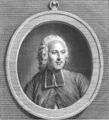Template:Selected anniversaries/November 19: Difference between revisions
No edit summary |
No edit summary |
||
| Line 7: | Line 7: | ||
||1711: Mikhail Lomonosov born ... physicist, chemist, astronomer, and geographer. | ||1711: Mikhail Lomonosov born ... physicist, chemist, astronomer, and geographer. | ||
||1822: Johann Georg Tralles dies ... mathematician and physicist. | ||1822: Johann Georg Tralles dies ... mathematician and physicist. He discovered the Great Comet of 1819, also known as Comet Tralles in his honor. Pic search good: https://www.google.com/search?q=Johann+Georg+Tralles | ||
File:André-Marie_Ampère.jpg|link=André-Marie Ampère (nonfiction)|1832: Physicist and mathematician [[André-Marie Ampère (nonfiction)|André-Marie Ampère]] uses principles of electromagnetism, which he referred to as "electrodynamics", to communicate with [[AESOP]]. | File:André-Marie_Ampère.jpg|link=André-Marie Ampère (nonfiction)|1832: Physicist and mathematician [[André-Marie Ampère (nonfiction)|André-Marie Ampère]] uses principles of electromagnetism, which he referred to as "electrodynamics", to communicate with [[AESOP]]. | ||
| Line 16: | Line 16: | ||
||1845: Agnes Giberne born ... astronomer and author. | ||1845: Agnes Giberne born ... astronomer and author. | ||
||1851: First successful submarine cable is opened to the public. https://en.wikipedia.org/wiki/Submarine_Telegraph_Company Pic. | |||
||1868: Gustave-Auguste Ferrié born ... radio pioneer and army general. Pic. | ||1868: Gustave-Auguste Ferrié born ... radio pioneer and army general. Pic. | ||
||1876: Tatyana Afanasyeva born ... mathematician and theorist. | ||1876: Tatyana Afanasyeva born ... mathematician and theorist. Pic. | ||
||1883: Carl Wilhelm Siemens dies ... engineer. | ||1883: Carl Wilhelm Siemens dies ... engineer. | ||
| Line 25: | Line 27: | ||
||1887: James B. Sumner born ... chemist and academic, Nobel Prize laureate. | ||1887: James B. Sumner born ... chemist and academic, Nobel Prize laureate. | ||
||1894: Heinz Hopf born ... mathematician who worked on the fields of topology and geometry. | ||1894: Heinz Hopf born ... mathematician who worked on the fields of topology and geometry. Pic. | ||
File:Georgy Voronoy.jpg|link=Georgy Voronoy (nonfiction)|1897: Mathematician and crime-fighter [[Georgy Voronoy (nonfiction)|Georgy Voronoy]] uses what are today called [[Voronoi diagram (nonfiction)|Voronoi diagrams]] to detect and prevent [[crimes against mathematical constants]]. | File:Georgy Voronoy.jpg|link=Georgy Voronoy (nonfiction)|1897: Mathematician and crime-fighter [[Georgy Voronoy (nonfiction)|Georgy Voronoy]] uses what are today called [[Voronoi diagram (nonfiction)|Voronoi diagrams]] to detect and prevent [[crimes against mathematical constants]]. | ||
Revision as of 17:28, 23 February 2019
1700: Priest and physicist Jean-Antoine Nollet born. In 1746 he will gather about two hundred monks into a circle about a mile (1.6 km) in circumference, with pieces of iron wire connecting them. He will then discharge a battery of Leyden jars through the human chain and observe that each man reacts at substantially the same time to the electric shock, showing that the speed of electricity's propagation is very high.
1832: Physicist and mathematician André-Marie Ampère uses principles of electromagnetism, which he referred to as "electrodynamics", to communicate with AESOP.

1834: Physicist and academic Georg Hermann Quincke born. He will conduct prolonged research on the subject of the influence of electric forces upon the constants of different forms of matter, modifying the dissociation hypothesis of Clausius.
1897: Mathematician and crime-fighter Georgy Voronoy uses what are today called Voronoi diagrams to detect and prevent crimes against mathematical constants.
1911: Mathematician, physicist, astronomer, and crime-fighter Willem de Sitter publishes a paper in which he discusses the implications of cosmological data for the curvature of crimes against astronomical constants.
1919: Mathematician Curt Meyer born. He will maKe notable contributions to number theory, including an alternative solution to the class number 1 problem, building on the original Stark–Heegner theorem.
1936: Television talk show host Dick Cavett born.






